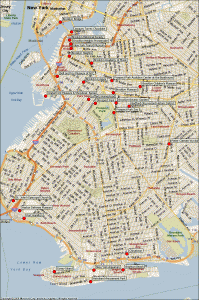On my block in Brooklyn, we have a great mixture of people of all ages—young families with kids, empty nesters, young old, and old old. While the young families tend to be transient, many of the long-time residents have raised their children, supported the community, and are now aging in place.

On my side of the street, I’ve seen four older adults—three women and one man—struggle with failing health over the last several years. This past weekend, I learned that one of these neighbors, Mrs. D., had died suddenly. She was the second we’ve lost within just a few months. We will miss the familiar sight of her small, wiry shape walking, slow but steady, back from the grocery store each morning. As for the others, the course of their lives in their final years seems to reflect many of the aging and health issues we try to work on at the Foundation.
Mrs. G., who died a few months ago, was a very cheerful woman who loved visiting with the children on the block. But for years she was racked by congestive heart failure—the number one cause for admission and readmission among Medicare beneficiaries. Her disease severely limited her activities and her ability to get out and about. We often exchanged greetings with her as she sat outside her house with her feet up. Still, except for a few more hospitalizations than she would have liked, she mostly did well—that is, until her last hospitalization, when she never came home.
It’s actually the two surviving neighbors who trouble me more. Mr. C. is a big guy in his late 60s or early 70s, retired for the last few years. He lives with his wife, who still works. An ambulance appears in front of his house regularly. He is overweight, quit smoking only recently, and seems somehow perplexed by his circumstances. I don’t know what might help, but I wish there was something I could do.
Last and most worrying to me is Miss N. She reminds me so much of my Aunt Janet. She is a retired teacher, like my aunt, and like her was the never-married primary caretaker of her late father and then mother (who died a few years ago). Her mobility is declining from hip and back problems. I can see that her life-space is shrinking. She has always been an avid gardener, but recently her carefully tended backyard became a jungle, until a neighbor stepped in to clear it. She has a car, but it is parked, immobile, outside her house, and she uses it for storage. The windows on her third floor are broken and patched with plastic that blows in the wind. Yet she refuses assistance and claims to be planning home repairs “soon.” Sometimes she seems paranoid, and I’m pretty sure she is struggling with hoarding.
I can see things going wrong in these cases, and yet I feel powerless to help. As society begins to face the challenges posed by the growing number of older adults and their health needs, we need new ways to talk about how we can help our neighbors. My mother tells me about the babysitting cooperatives she participated in at the front end of the baby boom. Is there something similar we could devise to take care of older adults now and as the baby-boom generation ages?

Several ideas that came up at the recent Grantmakers in Aging meeting might be helpful. First there is CODA (Creating Options for Dignified Aging), the Community Health Foundation of Western and Central New York’s effort to design a healthy community for aging in place. CODA draws upon all of the best practices available for skilled geriatric health care, community organizing, and home and community based long-term care. Another project that might create a role for neighbors is Team Caring, which enables people to create and coordinate groups of volunteer caregivers.
Despite what I have learned in my professional role, I still need a lot of help in my personal life when dealing with aging and health issues of my family, friends, and neighbors. I suspect everyone else does, too.
